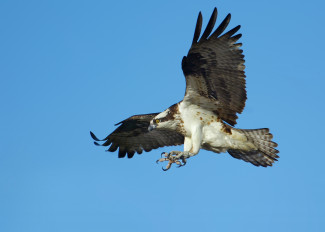
Johns Hopkins UniversityEst. 1876
America’s First Research University
Ospreys: The Revival of a Global Raptor

Why a book on Ospreys? It’s a question I get asked by casual friends, those who don’t know me well. My closer friends rarely ask the question. They know how thoroughly this magnificent bird of prey captures imaginations, how its arrival back each April from tropical wintering grounds helps us to banish winter and welcome spring, how a nest full of young Ospreys in August defines the overflowing bounty of summer. But there is more to Ospreys, much more, and in particular a surprising history that includes involvement with human cultures around the globe.
Part of the fascination of this fish-eating hawk is the reach of the species. From the forests of Hokkaido, Japan, to semi-desert islands off southern Australia; from Cuban mangrove swamps to Scottish forests; and from Oregon rivers to Canadian lakes, we find a species equally at home along a vast array of different rivers, lakes, and seacoasts. Many of these populations saw significant setbacks at the same time that US Ospreys did, and earlier. Although the threats that knocked ospreys back differed in each region--mostly guns and traps in Europe and loss of nesting habitat in other parts of the globe--the recoveries came along at much the same time. This renaissance was a reflection of changing attitudes, greening cultures, and the birth of environmentalism, especially in Europe and the Americas, starting in the 1970s.
We caught a break with Ospreys because they were such a receptive and forgiving species, and so amenable to management. Quick to adopt artificial sites for nesting, they were just as quick to adopt new regions when given the chance. Restoration efforts--transferring young before they can fly, and nurturing them in new habitats--have helped re-seed areas where Ospreys have long gone missing, from England to Spain to Tennessee. Success in all these efforts was aided by the extraordinary tolerance of this bird and its ability to live side-by-side with humans, even on the edge of industrial landscapes.

As a result, the species has developed a dedicated following, people intent on promoting its well-being. Consider them Osprey stakeholders. Shoreline retirees in Florida adopt nesting Ospreys as backyard “pets.” Finnish and UK bird-banders track down nests each summer in remote forests. Scottish trout farmers convert fish-filled ponds into meccas for Osprey photographers. Brazilian ecologists study wintering Ospreys on Amazon rivers. And Australian ornithologists scan cliffs from small boats, keeping tabs on nests for decades. All these actions and more have had helped the species thrive, keeping a finger on the pulse of Osprey well-being in ways that few would have thought to do a generation ago.
It is this almost universal awareness of the species, its “fame” if you will, that has defined Ospreys since the days of the great bird painter John James Audubon, and before. Living near this bird means (almost inevitably) that one is aware of it: prominent stick nests, sometimes loud with the calls of fledging young; soaring individuals on warm still afternoons, calling lazily to others below; the drama of a plunging Osprey, the large dark shape emerging from the water with a gleam of a silver fish in its talons; and for those lucky enough to live along an Osprey migration route, a stream of the distinctive brown and white wings passing overhead on certain days in fall and spring, as the birds vacate one continent for another in their continual search for warmth and fish.
For all of these reasons, the Osprey is as famed in our day as it was in Audubon’s. What we now know about this bird’s history makes it even more compelling. We celebrate its miraculous recovery from contaminants and guns, as well as its restoration to areas where less enlightened people drove it out. We appreciate its ability to serve as a barometer for levels of fish and poisons in our environment. And we stand in awe of its spectacular long-distance migrations, which Audubon knew little about. But in many ways it is the drama of its life, its central place in any habitat that supports it, that lets this great bird reach across time and distance to unite us in admiration. Few other birds have such a hold on the human imagination. My book, Ospreys: The Revival of a Global Raptor, is a quest to see why this is so.
Alan F. Poole, an associate at the Cornell Lab of Ornithology, is the former editor of the Birds of North America life history series. He is the author of Ospreys: The Revival of a Global Raptor. Poole has been studying New England Ospreys for over 35 years.


